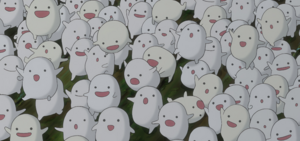Máthé Katalin: The power of not knowing
The power of not knowing
Article available at: https://www.ludovika.hu/en/blogs/ludovika-green-blog/2024/03/21/the-power-of-not-knowing/
Sidenotes to Miyazaki’s second Oscar
This piece is the beginning of a series – on the one hand, posts that concern the recent, 96th Academy Award winning movies from an environmental perspective, and writings that will praise the life and thought of Academy Award-winning animation movie director Hayao Miyazaki on the other. The general purpose of these posts is to explore the role of the arts in shaping our (environmental)consciousness. The suggestions of the present author are that art is an equally valid mode of uncovering the secrets of nature to the sciences and sustainability education does not have to directly address issues like recycling or clean energy to achieve shifts in behaviour.
On the 10th of March 2024 Hayao Miyazaki was announced for the second time as the winner of the category for Animated Feature Film at the 96th Academy Awards Ceremony in Hollywood. In every sense The Boy and the Heron is a true gift to humankind from the 83-year-old director, whose retirement from filmmaking has been in the air since the making of his 10th movie, Ponyo on the Cliff by the Sea that was released in 2008/2009. The harsh mental and physical demands of the unfolding of the story, the characters, and the visual world of an animated feature film placed on its creator can be witnessed in a 4-part documentary entitled 10 Years with Hayao Miyazaki which was recorded during the years Ponyo came to life. (link to a free-to-watch version)
The existence of this documentary cannot be appreciated enough; it required significant sacrifices from both its maker and Miyazaki himself. The former has lived in the shadows of Miyazaki for 10 years, being on guard to catch the moments of inspiration, to record a process that contains the greatest of teachings not only for professionals, but for anyone claiming to have figured it out about the potential of visual storytelling. The latter, Miyazaki himself, who, although excelled in his abilities to screen out outer stimuli from his internal landscape, an aptitude highly valued in Japan, was challenged at times when his most vulnerable moments were caught on camera. These 4 episodes that condense 10 years into 49-minute parts give us an idea not just about the magnitude of the energies invested into the coming to life of creative ideas but about the artistic approach to cracking the codes of reality.
What is most apparent in Miyazaki’s attitude is his absolute openness, who, even in his eighties, ventures into the unknown completely unarmed with previous experience, in the state of not-knowing. From our outcome-oriented, efficiency-based point of view it would be hard to approve a working method he exhibits. One of the greatest questions in the sustainability arena is “how do we deal with uncertainty?”, which is arising due to events occurring in ever greater frequency that shake our confidence gained through the accumulation of our technological-scientific expertise. For a creator like Miyazaki a reverse question is phrased: “where did all this confidence come from?” or “aren’t we arrogant insisting that the world must be solely about satisfying humans’ immediate needs?”.
This duality of attitudes is present in most of Miyazaki’s movies, and it is usually a father-figure – reminiscent to his own father – who represents the confident man of science or technology, who is in control of the events and outcomes, who feels completely empowered by his intellectual genius. In The Boy and the Heron, the protagonist, Mahito Maki’s father Shoichi Maki is an aviation engineer, who drives a car frantically around a landscape where anyone else moves around by muscle power, and while everyone is enchanted by the scenery, he never takes notice of his natural surroundings. The one instance he mentions beauty is his comment on his own technological creations, a series of glass coffin-like cockpits that he orders to be transported over his new wife’s property, a serene location where most of the story takes place.
Miyazaki does not take sides in his stories and does not encourage us to do so. The presence of dualities is not about the absolute good fighting the absolute devil. Shoichi Maki too is a hero of its own, with his own means he is a true protector of his family and a full-hearted participant in the war effort while not only the war is taking its toll on the entirety of society, but personal traumas need to be dealt with individually. All of Miyazaki’s characters are complex creatures with significant flaws that eventually come to be the source of their strength.
It would be impossible to draw one conclusion of this movie, or even to attempt plotting the storyline. Nothing is explicit in the cascades of visual delight that Miyazaki is showering us with, but it is interesting to note that probably nothing of the journey of the mind that us the viewers take part in is discernible for those of the movie characters that do not accompany Mahito on his journey. For most of his environment, he is just a troubled boy dealing with an identity crisis, acting weird, but altogether his entire drama is just a passing caprice, a personality flaw, that his surroundings generously forgive. This is how most of us treat each other, feeling entitled to judge others, assuming that we know what is going on with them. Miyazaki draws our attention that the problems of the world affect not only us humans but every form of creation, including plants, animals, and beings of all sorts.
Photo: Warawaras, the souls waiting to be born, probably the most enchanting characters of the movie, source: uhdpaper.com
